Bigfoot’s Killer-N 1102 Wireless Networking vs. the World
by Jarred Walton on August 10, 2011 10:38 AM ESTCisco/Linksys E4200 Dual-Band Ideal Performance
Now we switch over to the Linksys E4200 router, a dual-band router capable of up to three spatial streams on 5GHz, or two streams on 2.4GHz. Since several of the wireless cards don’t support 5GHz radios, we test with both radios on the router. For the Bigfoot 1102, Intel 6230, and Intel 6300 we enable only the 5GHz radio on the router, while for the other three wireless cards (Atheros, Intel 1030, and Realtek) we use the 2.4GHz radio. This is also going to be the real comparison for the Intel Ultimate-N 6300, as it can finally flex its 450Mbps muscle (in theory) to provide higher throughput. Again, we’ll start with the ideal tests before moving to an obstructed location.
Interestingly, many of the 2.4GHz cards actually perform worse with the Linksys router. It doesn’t matter whether we disable the 5GHz radio or not; the Atheros refuses to connect at anything more than 144Mbps (and is frequently at 130Mbps). The Realtek also negotiates a 72Mbps stream instead of 144Mbps. On the other hand, the Bigfoot 1102, Intel 6230, and Intel 6300 all connect at 300Mbps when we disable the 5GHz radio, so the two spatial streams are in fact working, but if any of these drop to a 144Mbps signal (20MHz vs. 40MHz channel), they’ll generally stay there. That’s often a “works as designed” feature, and the crowded 2.4GHz spectrum means a lot of cards will see enough stuff out there that they won’t even try for 40MHz channels, but it’s still irritating.
With the 5GHz radio enabled, the Bigfoot and Intel 6230 both connect at 300Mbps on their 5GHz radios, and the Intel 6300 achieves a 450Mbps connection…sometimes. Even though it’s in the same room as the router, the Intel 6300 often cycles between 450Mbps, 405Mbps, 360Mbps, and even 270Mbps. We worked to get it to link up at a relatively steady 450Mbps, and eventually found a sweet spot with the laptop balanced on top of a box in the center of the room, but it still drops to lower rates on occasion. Also odd is that the Atheros and Bigfoot both appear to report the maximum theoretical connection rate and don’t ever show lower values, even though performance clearly drops off. That means the Bigfoot always shows 300Mbps on 5GHz, and either 300Mbps or 144Mbps (depending on whether the router is using a 40MHz channel) for 2.4GHz.
We mentioned earlier that Bigfoot had a different set of parameters for the Netperf testing, and this is the only page where we’re using their results. As you’ll see below, TCP throughput actually improves on all of the cards compared to running the default test, but the UDP throughput is in the toilet for everyone other than Bigfoot. Intel in particular doesn’t do well on UDP with the settings recommended by Bigfoot, with all three tested Intel cards apparently capped at 3-4Mbps. This is very likely a driver optimization problem, and Bigfoot suggested that Intel has focused on 1000 byte packets for UDP performance, which is why performance drops. More on this in a second.
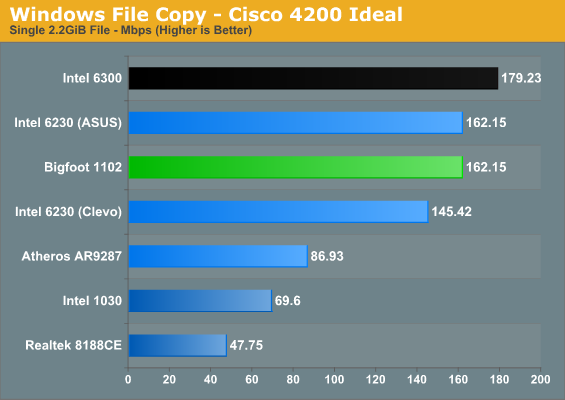
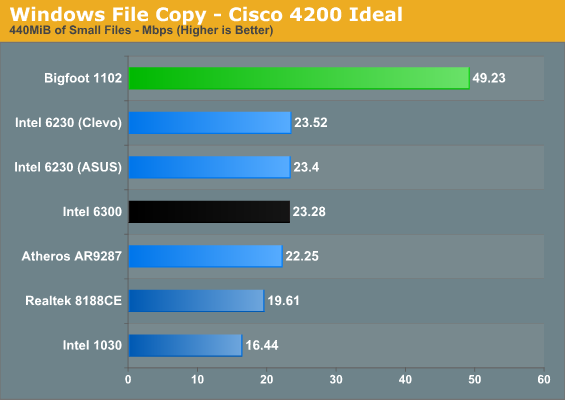

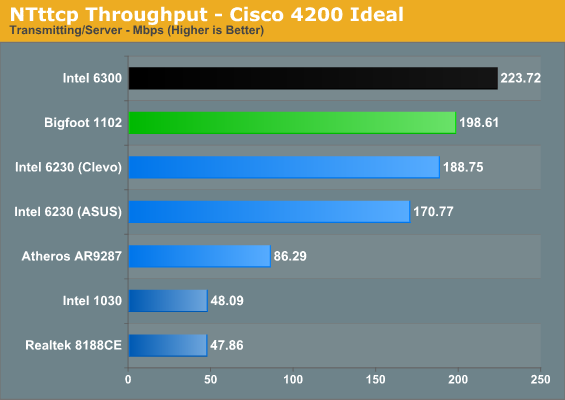
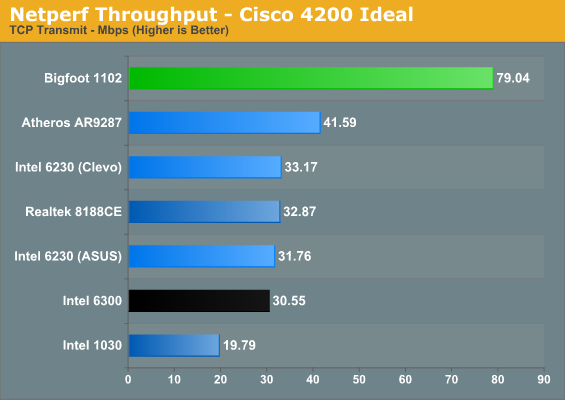
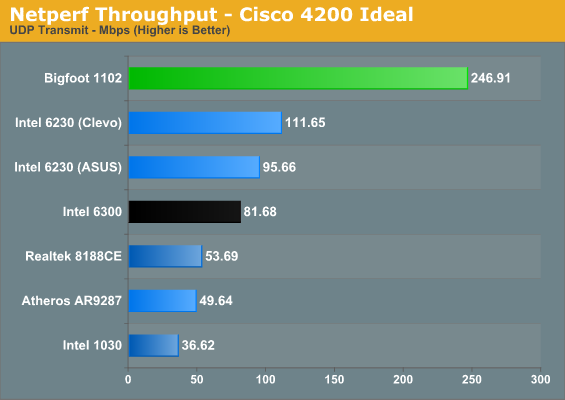
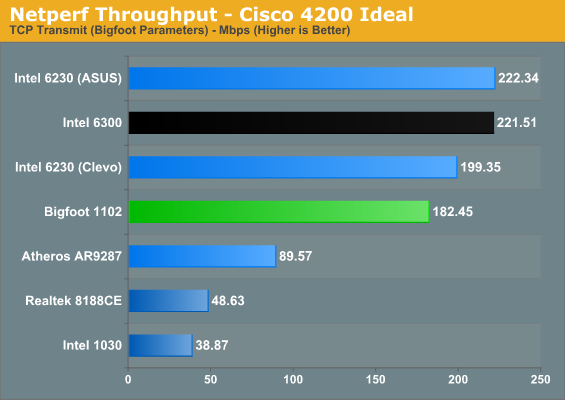
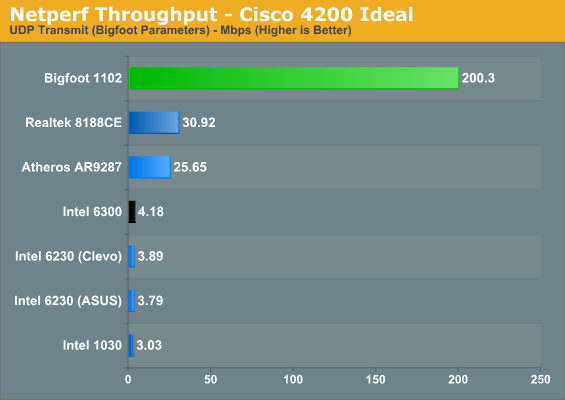
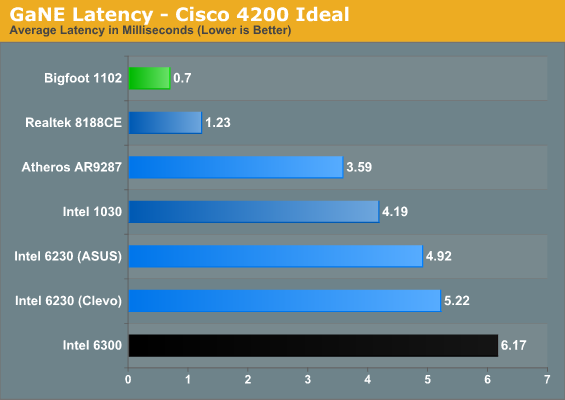
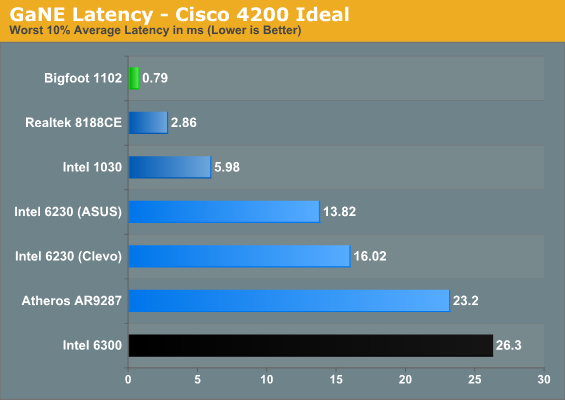
In our best-case results using the Linksys E4200, most of the performance patterns we saw with the Netgear router remain in place. The Bigfoot continues to provide stellar latency results—even better than with the 2.4GHz Netgear router—and this is reflected in the excellent small file copy result. However, now that we’re using a 5GHz radio, both Intel 6230 laptops perform much better, and the Intel 6300 can finally claim a few victories.
Where Intel’s 6300 shines is in raw throughput. The three spatial streams allow it to reach the highest raw bandwidth in NTttcp, coming in over 10% faster than the Bigfoot 1102, which in turn is about 10% faster than the Intel 6230. The single large file transfer also does well on the 6300, and the K53E 6230 manages to tie the Bigfoot—though the same laptop chassis with a 6230 still falls behind. Given the 2.4GHz radios and lower connection rates on the other cards, it’s no surprise that they fail to match the Bigfoot and Intel 6230/6300 results in tests where throughput matters.
Despite the great showing in the NTttcp tests, the Intel 6300 falters in the Netperf results and Bigfoot gets another victory. Using the default test setup, the Bigfoot 1102 actually delivered more than twice the throughput of the nearest competitor in Netperf. Switch to the Bigfoot parameters and the Intel 6230 and 6300 lead in the TCP test, but as noted above all of the Intel cards have a serious problem with the UDP testing. Of course, even if Bigfoot is correct and their UDP parameters reflect usage scenarios with larger packet sizes, we have to ask: does it really matter? UDP generally isn’t useful for transferring large amounts of data, and even 3Mbps is more bandwidth than most applications will ever need. It could be an issue down the road, but the Netperf UDP results (note that the results are for transmitting, not receiving) don’t necessarily come into play in the real world.
Do we still have a winner? It’s not quite as impressive as the results with the Netgear router, but overall the Bigfoot 1102 delivers the best experience with the Linksys router. Raw throughput isn’t often the bottleneck, particularly when gaming, and the consistency of connection, low latency, and extra utilities that Bigfoot offers certainly come in handy. If you had to pay $50 to $100+ more for the Bigfoot Killer Wireless-N wireless cards, like you did with their Ethernet Killer Networking cards, it wouldn’t be so easy to pick a winner. However, right now every laptop purchased from Mythlogic comes with the Bigfoot Killer Wireless-N 1102. If that’s not a ringing endorsement, I don’t know what is: Mythlogic is happy enough with the results they’ve seen on the 1102 that they’re no longer even bothering to offer Intel alternatives. If the 1102 is not enough, Mythlogic also offers Bigfoot’s Killer Wireless-N 1103 that supports 3x3:3 MIMO for another $15. We haven’t had a chance to test the 1103, but given the smackdown the 1102 delivers to the 2x2:2 competition, it’s pretty safe to assume the 1103 will reign supreme. (If we can get one for testing, we’ll be sure to put it through the same tests as we’ve done here.)










52 Comments
View All Comments
zephon85 - Wednesday, August 10, 2011 - link
Any words on the impact of the different wifi adapters on notebook battery life? Would be quite good to know how much (if any) time you gain by using different wireless cards...Gigantopithecus - Wednesday, August 10, 2011 - link
I could be wrong but given the upper limit on mini-PCI and mini-PCIe power capacity, I'd assume differences between cards on the same interface would be negligible in the real world. You might be able to demonstrate small statistically significant differences between cards using large sample sizes and very rigorous, controlled testing, but that's an enormous amount of time and effort to show that card X yields 5-6 more minutes of battery runtime than card Y.JarredWalton - Wednesday, August 10, 2011 - link
I'll cover the battery life question in the laptop review; I didn't actually take the time to perform those tests yet. I don't expect much of a difference, as WiFi adapters are usually pulling less than 250mW, but we'll see.Souka - Wednesday, August 10, 2011 - link
I'll put my $.02 in.Different cards have different drivers....each with their own defaul power settings.
Unless all the various options are taken into account, it can be really hard to get a apples-2-apples comparison of power needs.
But I agree to a point, the wi-fi power draw is really low compared to drive, memory, cpu, gpu, and LCD power needs.
Kinda think of driving a car with the antenna up vs down.... yes it does make a difference, but not much.
My $.02
:)
SquattingDog - Wednesday, August 10, 2011 - link
Just to post on this - Wireless being on or off can make a huge difference to battery life on notebooks - so some testing between cards could definitely be good. Eg on a Netbook I have (Asus n10jc), I typically get around 30 - 45min more battery life with wifi OFF.In saying that, since upgrading from a 54mbps wifi network to a 300mbps wifi network, I have seen no difference in battery usage on the machine (connects at 300Mbps now).
JarredWalton - Wednesday, August 10, 2011 - link
True, but you're looking at a netbook that idles at around 7W. A reduction in power draw of .25W would be a lot more noticeable on that than on a full laptop that's drawing 12-15W minimum.Souka - Wednesday, August 10, 2011 - link
with wi-fi on you may have a fair amount of network activity going on...which also increases the draw by the cpu/drive/mb/etcanyhow...good points all! :)
philosofool - Wednesday, August 10, 2011 - link
Wireless networking isn't something I really keep up on, so I don't know much past the various 802.11 names. What, forexample, does 3x3:3 mean and why might I like that more than some other configuration?A5 - Wednesday, August 10, 2011 - link
From Page 1 of the review:"While we’re on the subject, let’s clarify what the MIMO numbers mean. When we’re talking about a 2x2:2 part, the first digit is the number of transmit chains, the second is the total number of receive chains, and the third is the total number of data streams supported. It’s possible to have a 3x3:2 device, for example, which would use the extra transmit and receive chains to improve SNR (Signal to Noise Ratio), but the number of streams cannot be more than the larger of the transmit/receive chains (so 2x2:3 isn’t possible, but 2x3:3 is)."
Theoretically, a 3x3:3 device offers 3x the bandwidth of a 1x1:1 device.
GeorgeH - Wednesday, August 10, 2011 - link
Thanks for the review, it looks like my bias against everything "killer" will have to be adjusted a bit. While I'm still not sure that the performance difference is terribly meaningful, neither is $20 in most laptops.